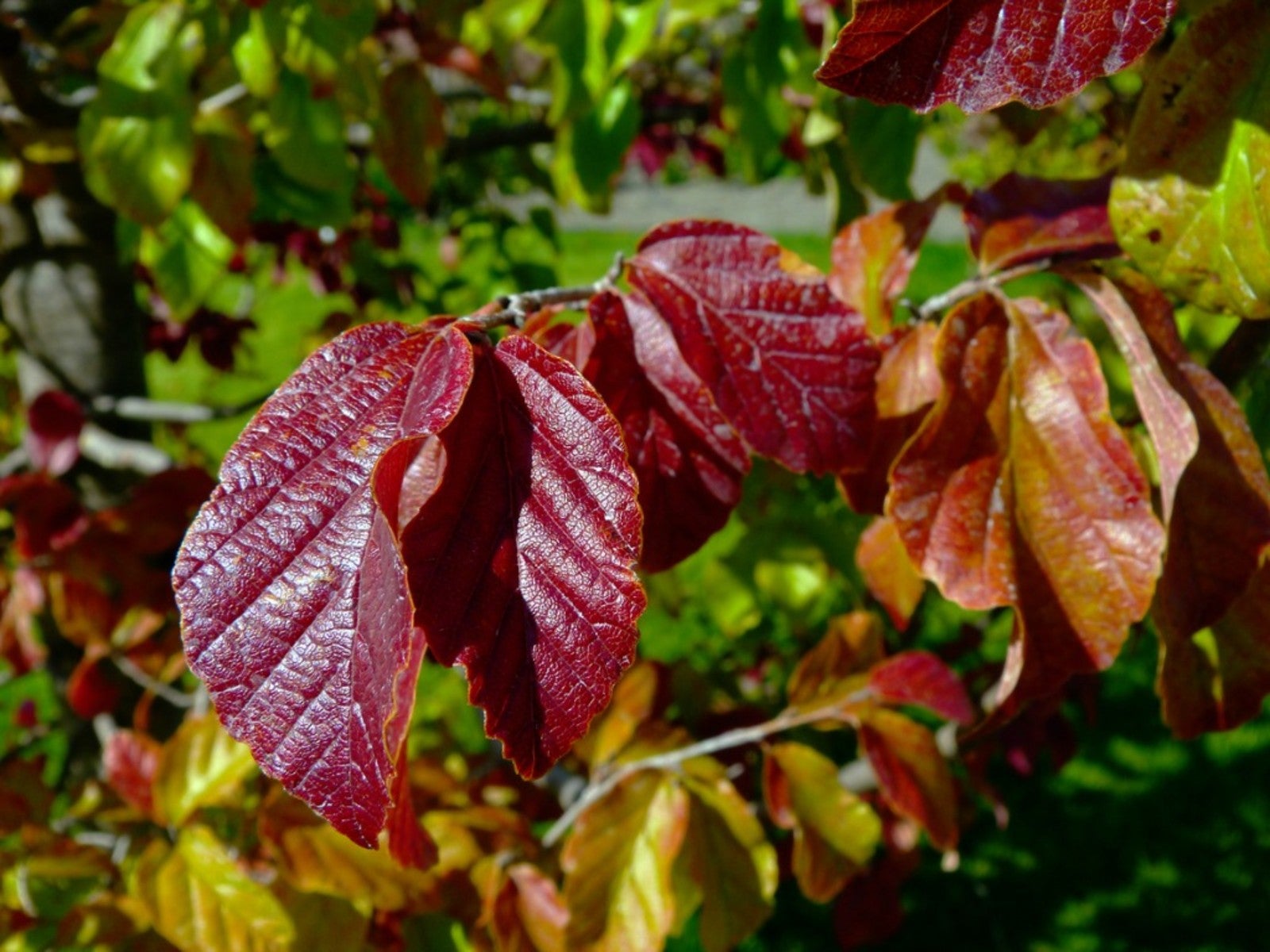Persian Ironwood Facts - How To Grow A Persian Ironwood Tree


The first time you see a Persian ironwood tree (Parrotia persica), you might think it would be better called a shrub. It is a tree that grows with many trunks and doesn’t get to a towering height, making it a good choice for smaller gardens.
Persian ironwood offers year-round interest with showy red flowers in spring and lovely, exfoliating bark on display in winter. Read on for more Persian ironwood facts, including tips on how to care for the tree.
Persian Ironwood Facts
It will not surprise you to learn that the Persian ironwood tree is native to Iran, modern-day Persia. It is a fairly small tree, topping out at 35 feet (11 m.) but is often seen shorter. The tree grows with many trunks and a rounded canopy.
According to Persian ironwood information, it branches quite low which means that it can be as broad as it is tall. It is relatively fast growing at 12 to 24 inches (30 to 60 cm.) per year.
Persian Ironwood Fall Color
This is a little deciduous tree that makes a real statement in your garden. It produces a mass of ruby red stamens in late winter and early spring. They appear on the bare branches and offer early color in the garden. Over time they develop into chocolate-brown seed capsules.
Leaves appear soon after. They are some 4 inches (10 cm.) long and emerge reddish-purple, the color deepening to a bright shade of green in summer. Then, in autumn, you can anticipate the much-admired Persian ironwood fall color as the leaves turns shades of yellow and orange before falling.
As Persian ironwood trees mature, the bark becomes ornamental as well. It peels back, leaving patches of gray, green, white and brown, providing a delightful display in winter.
Gardening tips, videos, info and more delivered right to your inbox!
Sign up for the Gardening Know How newsletter today and receive a free copy of our e-book "How to Grow Delicious Tomatoes".
Persian Ironwood Care
If you are considering growing a Persian ironwood tree, you will want to know more about its cultural requirements. Persian ironwood care is easier when the tree is planted in an appropriate site. It thrives in U.S. Department of Agriculture plant hardiness zones 4 through 7 or 8.
Plant your tree in fertile, slightly acidic soil. According to published Persian ironwood information, excellent drainage is a must. Select a location that gets direct sun most of the day. As far as irrigation, this tree likes regular water, but it can be drought resistant once established. What about pest issues? You have no reason to anticipate serious pest problems with the Persian ironwood tree.

Teo Spengler is a master gardener and a docent at the San Francisco Botanical Garden, where she hosts public tours. She has studied horticulture and written about nature, trees, plants, and gardening for more than two decades. Her extended family includes some 30 houseplants and hundreds of outdoor plants, including 250 trees, which are her main passion. Spengler currently splits her life between San Francisco and the French Basque Country, though she was raised in Alaska, giving her experience of gardening in a range of climates.
-
 Looking For Plants To Give You The Soft And Fuzzies? Try These 5 Fuzzy Leaf Plant Options
Looking For Plants To Give You The Soft And Fuzzies? Try These 5 Fuzzy Leaf Plant OptionsLovers of texture, drama, silver foliage and tactile plants will adore these special sensory garden additions. These fuzzy leaf plant options will leave you all aglow
By Susan Albert
-
 Get Ready For A Summer Of Hummers! Grow These Full Sun Hummingbird Plants and Flowers
Get Ready For A Summer Of Hummers! Grow These Full Sun Hummingbird Plants and FlowersIf you’re lucky enough to enjoy a sunny backyard, make sure you are maxing out on your pollinator opportunities and grow these full sun hummingbird plants and flowers
By Tonya Barnett
-
 Best Trees For Carbon Sequestration And Climate Change
Best Trees For Carbon Sequestration And Climate ChangeLet’s keep planting trees. They are our best bet for capturing carbon and may help with our global warming issues.
By Teo Spengler
-
 7 Invasive Trees You Should Never Plant In Your Yard Or Garden
7 Invasive Trees You Should Never Plant In Your Yard Or GardenWhat are some invasive trees you should never plant in your yard? Click here to find out.
By Teo Spengler
-
 How Close Can You Plant A Tree To A Stump?
How Close Can You Plant A Tree To A Stump?Looking to plant new trees near old stumps or where stumps have been removed? Click here to learn how.
By Teo Spengler
-
 Messiest Trees That Drop Debris Everywhere
Messiest Trees That Drop Debris EverywhereWant to know which trees will create the biggest messes in your home landscape? Click here to find out.
By Amy Grant
-
 How To Get Rid Of Tree Sprouts In The Yard From Nearby Trees
How To Get Rid Of Tree Sprouts In The Yard From Nearby TreesLearn the simple way to keep pesky tree seedlings in your lawn from becoming saplings.
By Teo Spengler
-
 How To Tell How Old A Tree Is
How To Tell How Old A Tree IsEver wondered how to calculate the age of a tree? Click here to learn all about it.
By Teo Spengler
-
 When To Remove Tree Stakes From Saplings
When To Remove Tree Stakes From SaplingsA newly planted tree may grow strong when it’s staked, but don’t forget to remove the stakes when it’s stable.
By Teo Spengler
-
 Inosculation And Trees Growing Together
Inosculation And Trees Growing TogetherIf you ever see two trees that have bonded and grown together, read here to learn why and how it happens.
By Teo Spengler